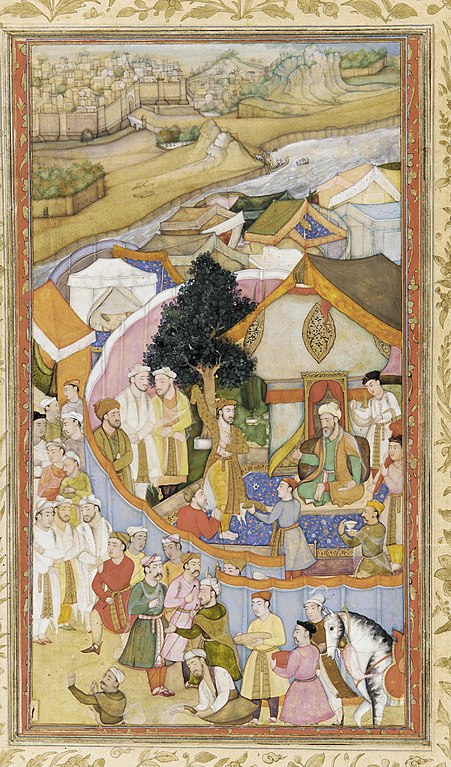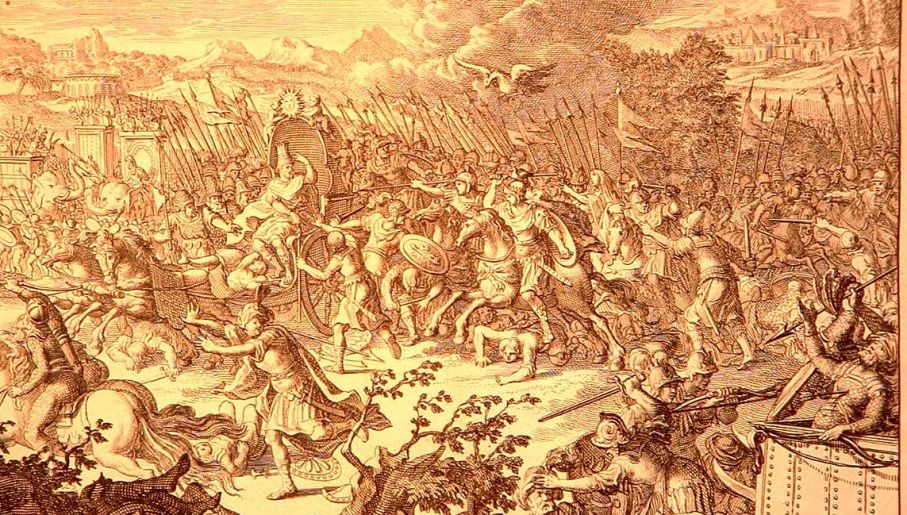The Battle of Tukaroi, also known as the Battle of Bajaura or the Battle of Mughulmari, was fought on March 3, 1575 near the village of Tukaroi now in Balasore District of Odisha.
This battle was fought between the Mughals army and the Sultanate of Bengal and Bihar on 3 March 1575. It resulted in the Mughal secession of Bengal.
Battle of Tukaroi
Nabadwip, Ikhtiaruddin Muhammad bin Bakhtiyar Khilji of the Delhi Sultanate defeated Sena King Lakshman Sen in 1203-1204 in his capital and invaded most of Bengal.
When the Mughal Emperor was Akbar, Daud Khan Karrani was the ruler of Bengal (Sultan of Bangal). Karrani ‘s dreams were high and he wanted to conquer the entire subcontinent. He conquered the Fort of Zamania, which was a Mughal Empire frontier post.
The Battle of Tukaroi

Da’ud Receives a Robe of Honor from Mun’im Khan
Da’ud Receives a Robe of Honor from Mun’im Khan (courtesy Wikipedia)
This gave the reason for the war to Akbar. When he heard this news, he was in Gujarat. He was furious and ordered Daud to be severely punished by his trusted leader, Munim Khan, and representatives of imperial power in Jaunpur. Munim raised a mighty force and marched to Patna. However, Lodi Khan, a powerful Afghan leader who had installed Daud on the throne and was now serving as prime minister, opposed Munim Khan. Munim Khan was aged and had lost his energy and was willing to negotiate peace after some small wars and offer Daud extremely lenient terms.
This dissatisfied Akbar, who sent Raja Todar Mal, one of his trusted ministers, to take over Bihar. Lodi Khan, meanwhile, was deceitfully killed by Karrani, who confiscated his property as well.
Munim Khan, stung by the censure of his master, returned to Patna and laid siege to the town. But he soon realised the challenge of bringing it beyond his powers and begged Emperor Jalal ud-Din Muhammad Akbar of the Mughal Empire to come in person and take over the campaign.
After paying his annual visit to Ajmer, Akbar, who had just returned to the capital, proceeded to Agra in March 1574 and prepared a fleet of elaborately built boats for the river. On June 15th, he began his voyage and was accompanied by 15 of his best soldiers. He captured Hajipur in 1574, from where he supplied Patna with supplies. Also, he captured the Patna fort.
You can read our another post on The Leaning Temple of Huma: A Unique Architectural Wonder
He then gave an additional 20,000 men to Munim Khan and made him the governor of Bengal. The Mughal army marched into Tanda (near Gaur), the capital of Bengal, and Daud retreated to Odisha. The action forced the engagement of Munim Khan before he was able. The Mughal commander suffered many critical wounds in the early stages of the war and the Bengal army appeared assured of victory. But later that day, the fall of General Gujar Khan of Daud caused fortune to move sides and led to the complete defeat of Daud, who had escaped from the ground. The war led to the Katak Treaty, in which Daud ceded Bengal and Bihar as a whole, retaining only Odisha.
Effects After the Battle of Tukaroi
The Battle of Tukaroi
The Battle of Tukaroi (courtesy Smithsonian, Pinterest)
Six months later, Munim Khan died in October 1575. Daud Karrani came out of Orissa, marched into Bengal and advanced as far as Teliagarhi, seizing the chance, and thus became again, together with Orissa, the master of West and North Bengal. The governor of Bengal, adorned with the word,’ Khan Jahan,’ Akbar named Husain Quli Beg, and ordered him to attack Daud.
Daud Karrani posted about 3000 select Afghans at Teliagarhi at the approach of the Mughal army under Khan Jahan to protect the pass, and he himself took position with the rest of the forces in the Rajmahal hills. At Tellynagari, Khan Jahan met the Afghans and took control of the pass by means of a furious battle. He then marched to Rajmahal against Daud Karrani. The Mughals were defeated in one skirmish. Akbar ordered Bihar Governor Muzaffar Khan Turbati to join Khan Jahan and ordered other generals to join the shiploads of provisions and ammunition.
The key Afghan leaders, such as Junaid, Qutlu Khan and Kalapahar, all gathered around Daud Karrani. Finally, at Rajmahal on 12 July 1576, a decisive battle was fought. In the end, Daud was defeated and executed. He was the last independent Muslim king in Bengal.
Conclusion
In the end, the battle of Tukaroi did not affect Odisha all that much. However, it did unify Odisha and Bengal into a single territory. This concept managed to survive for 400 years before Odisha became its own independent state during the British Raj.
This battle also et to the end of the Bengal Sultanate and the ascension of the Mughal Empire.
References
https://www.thehindu.com/todays-paper/tp-features/tp-youngworld/monsoon-conflict/article17399376.ece
http://en.banglapedia.org/index.php?title=Daud_Khan_Karrani
http://www.leadthecompetition.in/GK/history/battles-during-mughal-rule.html

